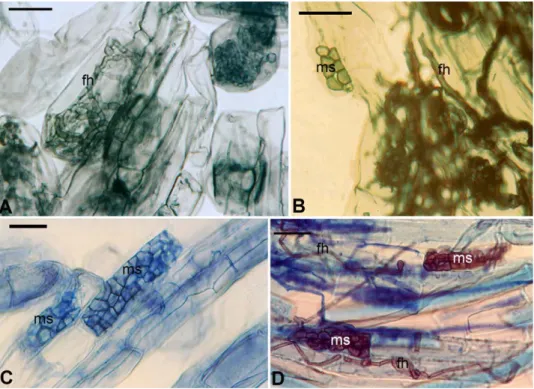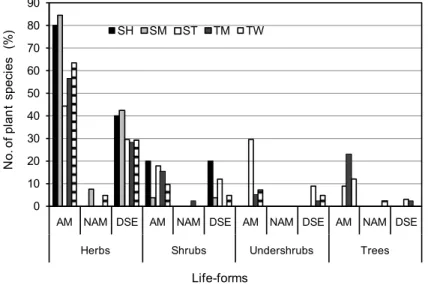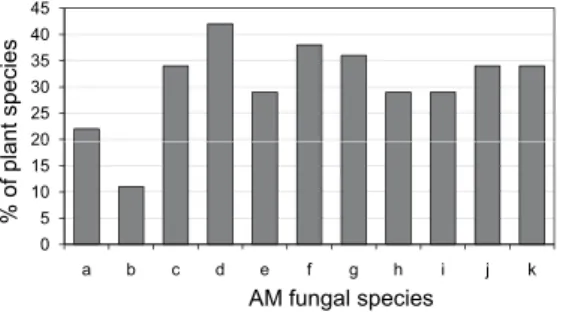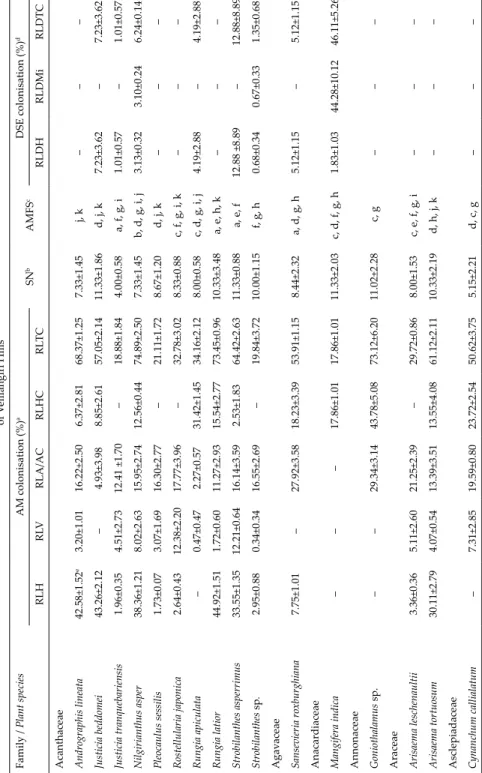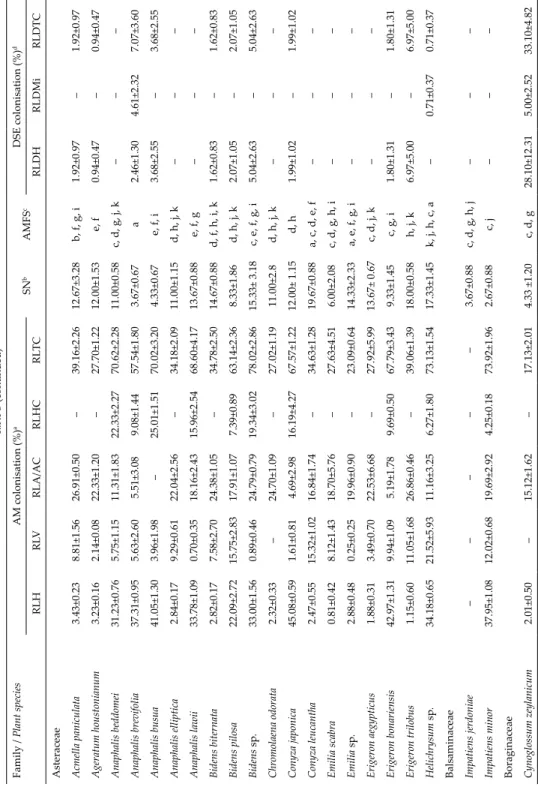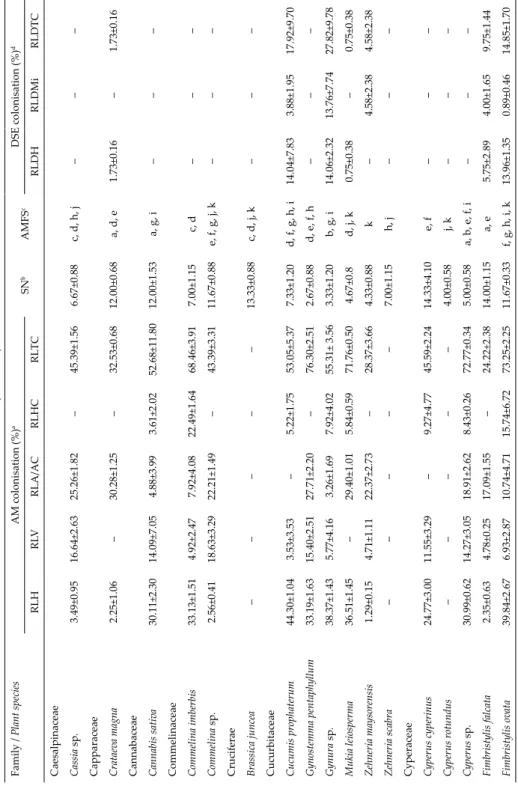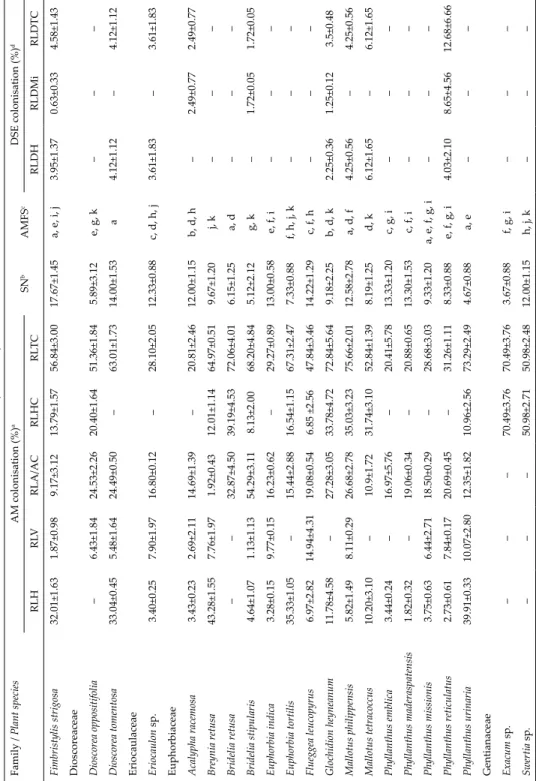ARBUSCULAR MYCORRHIZAL AND DARK SEPTATE ENDOPHYTE FUNGAL ASSOCIATIONS IN PLANTS OF DIFFERENT VEGETATION TYPES IN VELLIANGIRI HILLS
OF WESTERN GHATS, SOUTHERN INDIA
T. Muthukumar1*, K. Sathiyadash1,2 and V. Valarmathi1
1Root and Soil Biology Laboratory, Department of Botany, Bharathiar University Coimbatore 641 046, Tamil Nadu, India; E-mail: *tmkum@yahoo.com
2Department of Botany, Thiagarajar College, Madurai 625 009, Tamil Nadu, India
(Received 21 June, 2017; Accepted 16 August, 2017)
In recent years more attention is being paid to the presence of various non-pathogenic root fungal associations in plants of natural ecosystems for their role in various ecosystem pro- cesses. Despite their widespread reports in various ecosystems worldwide, our knowledge on root endophyte fungal association in plants from natural vegetation is far from com- plete. We assessed the arbuscular mycorrhizal (AM) and dark septate endophyte (DSE) fungal association in plants of Velliangiri Hills of the southern Western Ghats region, due to limited information on the root fungal association in this region. Of the 147 plant taxa (belonging to 46 families) investigated from five different vegetation types ranging from montane grasslands to tropical rainforest, 141 were colonised by AM fungi and co-occur- rence of DSE fungi along with AM fungi was observed in 74 plant taxa. We report AM and DSE fungal associations for the first time in 61 and 42 plant species, respectively. Determi- nation of AM morphological types indicated the frequent occurrence of intermediate type and AM morphology is reported for the first time in 64 plant taxa. Spore morphotypes be- longing to eleven species (in six genera) were isolated from the different vegetation types.
Arbuscular mycorrhizal fungal spore numbers neither differed significantly among veg- etation types nor were related to AM fungal colonisation. Spores of Funneliformis geosporum was the most frequent spore morphotypes. Dark septate endophyte fungal association oc- curred in plants of all the vegetation types and was most frequent in herbs. Though no significant relationship was found between AM and DSE fungal colonisation within roots, a positive association was found in the occurrence of these two fungal groups.
Key words: AM fungi, Arum-type, DSE fungi, Glomus, intermediate type, Paris-type
INTRODUCTION
Arbuscular mycorrhizal (AM) fungi are the most common and wide- spread soil fungi associating with plant roots. Belonging to the phylum Glome- romycota, these fungi are presumed to associate with around 86% of the vas- cular plant taxa (Brundrett 2009). The AM fungal hyphal network in the soil plays an important role not only in initiating root colonisation, but also mediate nutrient uptake and their distribution among plants (Smith and Read 2008).
Thus, AM fungi create functional linkages between biotic and abiotic compo- nents of the soil system (Berruti et al. 2015), affecting ecosystem processes like plant growth and productivity, as well as the structure and diversity of natural plant communities (Yang et al. 2016). In spite of over a century of assessment of the mycorrhizal status of plant species from different ecosystems worldwide, only less than 10% of the vascular plants have been actually examined for their mycorrhizal status (Brundrett 2009). Even for the plant taxa whose mycorrhizal status is known, the data at times are inconsistent or conflicting due to various levels of misdiagnosis (Brundrett 2009). In addition, it is also essential to exam- ine plant taxa over a range of environmental conditions and habitat types to ascertain factors that may possibly influence their mycorrhizal status.
Root colonisation patterns of AM fungi within plant roots are catego- rised as Arum-, Paris- or intermediate types based on the spread and location of the intraradical structures of the AM fungi (Dickson 2004). The colonisation pattern is termed Arum-type when the fungus spreads intercellularly with intracellular hyphae differentiating into arbuscules in root cortical cells. In the Paris-type AM morphology, the spread of the fungus is chiefly intracel- lular forming hyphal or arbusculate coils. The colonisation patterns sharing features of both Arum- and Paris-types are termed as intermediate types. Al- though root colonisation patterns have been reported for plants from differ- ent vegetation formations, these represent only a small percentage of plant taxa where mycorrhizal status have been investigated (Dickson et al. 2007). It has been suggested that Arum-type colonisation patterns predominate roots of plants with high root growth rates, while Paris-type colonisation patterns are formed by plants with slow growing and long lived roots (Brundrett et al. 1990, Dickson et al. 2007). Experimental evidence has shown substantial transport of phosphate to the plant host through the fungal interphase in the different types of AM morphologies (Dickson et al. 2007).
Arbuscular mycorrhizal fungal colonisation in plant roots are influenced by both the presence and density of AM fungal propagules. Even though, AM fungi can perennate through different types of propagules like soil hyphae and mycorrhizal roots, the major propagules of AM fungi are the spores (Ber- ruti et al. 2015, Grilli et al. 2015). Spores are also used to determine AM fungal community composition in different ecosystems (Grilli et al. 2015). Only lim- ited studies have examined the AM fungal community composition in tropi- cal ecosystems (Öpik and Davison 2016). Such assessments included tropical vegetation in China (Yang et al. 2013, Yu et al. 2017, Zhang et al. 2004, Zhao et al. 2003), Panama (Mangan et al. 2004, Schappe et al. 2017), Brazil (da Silva et al.
2017, Sturmer and Siqueira 2006, Zangaro et al. 2007), Costa Rica (Lovelock et al. 2003, Picone 2000) and India (Devi et al. 2017, D’Souza and Rodrigues 2013, Kumar and Adholeya 2016, Muthukumar and Udaiyan 2000a, 2002, Muthuku- mar et al. 2006, Radhika and Rodrigues 2010, Ragupathy and Mahadevan 1993).
Plant roots in natural habitats are also frequently colonised by fungi with dematiaceous, septate hyphae forming microsclerotia or moniliform hyphae.
These fungi are denoted as dark septate endophyte (DSE) fungi and often coexist with different mycorrhizal fungi (Mandyam and Jumpponen 2005, Newsham 2011). Although previous studies indicate a negative, neutral or positive influence of DSE fungi on plant performance, recent studies do in- dicate a positive effect of these fungi on plant growth and yield (Zhang et al.
2012). Mandyam and Jumpponen (2005) concluded that DSE fungi are preva- lent in various habitats, but information on their prevalence in tropical eco- systems is scanty. Only limited studies (e.g. Muthukumar and Prabha 2013, Muthukumar et al. 2006, Rains et al. 2003, Uma et al. 2010) have examined the occurrence of DSE fungal association in tropical plant species.
Velliangiri Hills (long. 6° 40’ to 7° 10’ E and lat. 10° 55’ to 11° 10’ N) is a mountain range in the Nilgiri Biosphere Reserve of Western Ghats, Southern India. The mountain peaks vary in their altitudes from 520 to 1,800 m a. s. l.
The mean annual rainfall is quite variable ranging from 500 to 7,000 mm. The average temperature ranges between 0 °C during winter and 41 °C during summer. The variability in altitudes and climatic conditions has resulted in different vegetation types ranging from grassland to tropical rainforest cover- ing these hill ranges supporting a wide variety of flora and fauna (Murugesan and Balasubramanian 2008). The 48 km2 hill range consists of around 1,715 species of angiosperms including 439 endemics (Murugesan 2005, see Ragu- pathy et al. 2008 and references there in). The vegetation in Velliangiri Hills is presently under immense threat as the result of various anthropogenic activi- ties (Balasubramanian and Murugesan 2004, Ragupathy et al. 2008). A previ- ous study has shown that AM and DSE fungal association occur in grasses of this region (Sathiyadash et al. 2010). Apart from that study, there is no infor- mation on root fungal associations in plants of Velliangiri Hills. So the aim of the present investigation was therefore to record the AM and DSE fungal association in plants of different vegetation types in Velliangiri Hills. We also assessed the extent of variation in fungal colonisation and AM fungal spore numbers across species, life-forms, and vegetation types. Further, we also iso- lated and identified spores of AM fungi in soil samples of the plant taxa inves- tigated. The relationship between various fungal variables was also assessed.
MATERIALS AND METHODS Sampling
The samples of roots and soils of 147 taxa (94 herbs, 19 shrubs, 15 under shrubs and 19 trees) were collected from five different vegetation types south- ern tropical thorn forest (ST), tropical moist deciduous forest (TM), tropical wet
evergreen forest (TW), shola forest (SH) and southern montane humid grass- land (SM) in June 2009 (Table 1). More details on the vegetation types have been provided by Murugesan (2005) and Murugesan and Balasubramaniam (2008). Three plants were sampled for each taxon. Herbs were usually dug out and roots for shrubs and trees were traced back to the stem. Roots were washed clear of soil and preserved in formalin, acetic acid and 70% alcohol (5:5:90;
v/v/v) solution and transported to the laboratory for processing. Soil shaken from roots and adjacent to plant roots was collected; air dried and packed in- dividually in polythene bags. One-half of these soil samples were used for the enumeration and isolation of AM fungal spores. The other half of the soil sam- ple from all the plants of a vegetation type was bulked to form a composite soil sample. This composite soil sample was used for determining soil characters.
Determination of soil characters
The air dried composite soil samples were sieved (2 mm grid) and three subsamples of the composite sample were analysed for the following charac- ters. Soil pH and EC was determined in 1:2.5, soil:water (v/v) solution after incubation for 20 min, with digital pH and conductivity meters, respectively, soon after the soil samples were brought to the laboratory (Jones 2001). To- tal nitrogen (N), was determined using the micro-Kjeldahl method, available phosphorus (P) was determined with the method by Bray and Kurtz (1945) and exchangeable potassium (K) was measured with a digital flame photom- eter after extraction in an ammonium acetate solution (Jackson 1971).
Table 1
Soil characteristics (mean±standard error) and the number of plant taxa examined from the different vegetation types of Velliangiri Hills.
Vegetation types#
ST TM TW SH SM
Soil type Sandy soil Sandy soil Sandy
clay loam Sandy clay
soil Clay soil
pH 7.40±0.09 7.90±0.09 7.10±0.10 7.97±0.11 7.42±0.07
Ec (dSm–1) 0.10±0.01 0.60±0.02 0.60±0.01 0.69±0.22 0.80±0.05 Nitrogen (mg/kg) 7.60±0.24 7.70±0.21 7.30±0.13 10.80±0.38 16.20±0.36 Phosphorus (mg/kg) 0.84±0.03 0.62±0.02 0.74±0.04 0.13±0.01 0.60±0.02 Potassium (mg/kg) 24.00±1.41 22.00±1.00 23.00±0.84 17.40±0.41 16.20±0.36
No. of taxa examined 34 39 42 06 26
#ST = southern tropical thorn forest; TM = tropical moist deciduous forest; TW = tropical wet evergreen forest; SH = shola forest; SM = southern montane humid grassland
Preparation of roots for AM and DSE fungal assessment
The root samples were washed free of FAA, cut into 1-cm pieces, cleared in 2.5% KOH (Koske and Gemma 1989), acidified with 5 N HCl and stained with trypan blue (0.05% in lacto glycerol) overnight. Roots that remained dark after clearing were bleached using alkaline H2O2 prior to acidification. Ten to thirty stained root bits were examined for each plant with a compound microscope (×400) for the presence of AM and DSE fungal structures. The percentage root length colonised by AM and DSE fungi and the root length containing different fungal structures were estimated according to the magni- fied intersection method (McGonigle et al. 1990). Ten intersection points were scored for each root bit. Only root specimens containing arbuscules/arbuscu- late coils were considered to be mycorrhizal. Melanised hyphae with regular septation and microsclerotia were used to designate DSE fungal association.
The AM and DSE fungal status of plant species in the present study were com- pared to previous literature (Harley and Harley 1987, Wang and Qiu 2006) to assess the information on their endorhizal status.
Determination of AM fungal morphology
The AM-morphology was classified as Arum-, Paris- or intermediate types based on whether the fungal hyphae were passing through the intercellular spaces or within cells as coils, respectively, following the descriptions of Dick- son (2004). We did not distinguish the intermediate subtype morphologies de- scribed by Dickson (2004) as only the whole and squashed roots were examined.
However, when the parallel running hyphae were intracellular, the morphol- ogy was designated as intermediate type. The AM morphological types of the plant species was compared to those presented by Dickson et al. (2007).
Isolation, enumeration, and identification of AM fungal spores
Spores of AM fungi were recovered from 100 g soil samples by wet-siev- ing and decanting technique (Muthukumar et al. 1996). The residues from the sieves (710 and 37 µm) were collected over filter papers, spread on a Petri dish and viewed under a dissection microscope at ×40 magnifications. Only intact spores were counted. For enumeration, spore clusters and sporocarps were considered as one unit. Permanent slides of AM fungal spores for identifica- tion were prepared by transferring all the intact AM fungal spores onto a glass slide containing polyvinyl-alcohol-lacto glycerol with or without Melzer’s re- agent (Schenck and Perez 1990). Spores were cracked open for observation of spore wall characters. Spore characters were compared with the original de- scriptions present in databases established by the Schüβler laboratory (http://
www.amf-phylogeny.com/) and cultural database of INVAM (http://www.
invam.caf.wvu.edu). Arbuscular mycorrhizal fungal nomenclature is that of Schüβler and Walker (2010). The frequency of each AM fungal spore morpho- type was calculated as the number of plant taxa in which spore of a particular morphotype occurred by the total number of plant taxa examined ×100.
Life-history attributes and plant nomenclature
Each plant taxon sampled during the survey was categorised for its life- form and life-cycle attributes as determined directly from the field observations or literature (Henry et al. 1987, 1989, Nair and Henry 1983, Prain 1981a, b, Toby and Hodd 1982). Plant nomenclature and authorities are as The Plant List (2013).
Statistical analysis
The data on soil characteristics were subjected to Analysis of Variance (ANOVA) and the means were separated using Duncan’s Multiple Range Test (DMRT). Percentage frequency of occurrence of different fungal asso- ciation in different habit was calculated using the formula: Number of taxa in a habit with specific fungal association/total number of taxa in the habit examined ×100. Data on fungal colonisation and AM fungal spore numbers were analysed using Kruskal–Wallis non-parametric analysis to assess the significance of the variation among plant species and vegetation types. The relationship between various AM and DSE fungal variables were analysed by Pearson’s correlation. We also used the probabilistic co-occurrence model using R package co-occur available on Comprehensive R Archive Network (https://CRAN.R-project.org/package=cooccur) to assess the nature of associ- ation (positive, negative or random) between AM and DSE fungi as well as the AM fungal species associated with different plant species (Griffith et al. 2016).
RESULTS Soil properties
Soils of different vegetation types in Velliangiri Hills were sandy to sandy clay loam. All soils were near neutral to slightly alkaline and the pH significantly varied among the vegetation types (F4,24 = 15.425; P < 0.001). The EC significantly differed among the vegetation types (F4,24 = 6.866; P < 0.001).
and ranged between 0.10 dSm–1 and 0.80 dSm–1. The N (F4,24 = 182.069), P (F4,24 = 109.062) and K (F4,24 = 15.276) contents of the soils significantly (P < 0.001) var- ied among the vegetation types and ranged from 7.6 to 16.2 mg/kg, 0.13 to 0.84 mg/kg, and 16.2 to 24 mg/kg, respectively.
Occurrence of AM and DSE fungi in various vegetation types
One hundred and forty-one of the 147 plant taxa (46 families) exam- ined from the different vegetation types had AM fungal structures in their roots (Table 2). Plants roots belonging to non-mycorrhizal families like Com-
Table 2
Life history attributes, arbuscular mycorrhizal, dark septate endophytic fungal associa- tion and colonisation morphology in angiosperms of Velliangiri Hills. Abbreviation: Veg- etation type = VT, Habit = Ht, Fungal association = Fa, AM type = At, Plant status = Ps
Family/Plant species VTa Htb Fac Atd Pse
Acanthaceae
Andrographis lineata Nees SM H AM* I*
Justicia beddomei (C. B. Clarke) Bennet ST S AM*, DSE* I*
Justicia tranquebariensis L. ST US AM*, DSE* A*
Nilgirianthus asper Santapau SH S AM*, DSE* I*
Pleocaulus sessilis (Nees) Bremek. SH H AM* A*
Rostellularia japonica (Thunb.) J. L. Ellis TW H AM* A*
Rungia apiculata Bedd. TW US AM*, DSE* P*
Rungia latior Nees TW H AM* I*
Strobilanthes asperrimus Nees SM S AM*, DSE* I*
Strobilanthes sp. SM H AM, DSE A
Agavaceae
Sansevieria roxburghiana Schult. et Schult. f. ST S AM, DSE I EI Anacardiaceae
Mangifera indica L. ST T AM, DSE P EI
Annonaceae
Goniothalamus sp. TW H AM I
Araceae
Arisaema leschenaultii Blume Rumph. TW H AM A
Arisaema tortuosum (Wall.) Schott. TW H AM I
Asclepiadaceae
Cynanchum callialatum Buch.-Ham. ex Wight TW S AM I
Asteraceae
Acmella paniculata (Wall. ex DC.) R. K. Jansen TW H AM, DSE* A EI
Ageratum houstonianum Mill. TW H AM*, DSE* A*
Anaphalis beddomei Hook. f. TW US AM* I*
Anaphalis brevifolia DC. TW H AM*, DSE* I*
Anaphalis busua (Buch.-Ham.) DC. TW H AM*, DSE I*
Table 2 (continued)
Family/Plant species VTa Htb Fac Atd Pse
Anaphalis elliptica (DC.) DC. TW H AM* A*
Anaphalis lawii (Hook. f.) Gamble. TW H AM* I*
Bidens biternata (Lour.) Murr. et Sherff. TM H AM*, DSE* A*
Bidens pilosa L. TM H AM*, DSE* I*
Bidens sp. TM H AM, DSE I
Chromolaena odorata (L.) R. M. King et H. Rob. ST S AM* A*
Conyza japonica (Thunb.) Less. ex Less. TW H AM*, DSE* I*
Conyza leucantha (D. Don) Ludlow et P. H. Raven TM H AM * A*
Emilia scabra DC. SH H AM* A*
Emilia sp. SH H AM A
Erigeron aegypticus L. TM H AM* A*
Erigeron bonariensis L. TM H AM*, DSE* I*
Erigeron trilobus (Decne.) Boiss. TM H AM*, DSE* A*
Helichrysum sp. SM H AM, DSE I
Balsaminaceae
Impatiens jerdoniae Wight TW T NM –
Impatiens minor (DC.) Bennet TW H AM* I*
Boraginaceae
Cynoglossum zeylanicum (Vahl) Brand TM H AM*, DSE* A*
Caesalpinaceae
Cassia sp. ST US AM A
Capparaceae
Crataeva magna (Lour.) DC. ST T AM, DSE* A* EI
Cannabaceae
Cannabis sativa L. SM H AM* I* EI
Commelinaceae
Commelina imberbis Ehrenb. ex Hassk. SM H AM* I*
Commelina sp. SM H AM A
Cruciferae
Brassica juncea (L.) Czern. TW H NM – EI
Cucurbitaceae
Cucumis prophaterum L. ST H AM*, DSE* I*
Gynostemma pentaphyllum (Thunb.) Makino TM H AM* I*
Gynura sp. TM H AM, DSE I
Table 2 (continued)
Family/Plant species VTa Htb Fac Atd Pse
Mukia leiosperma (Wight et Arn.) Wight ST H AM*, DSE* I*
Zehneria maysorensis (Wight et Arn.) Arn. TW H AM*, DSE* A* RA
Zehneria scabra Sond. TW H NM – EI
Cyperaceae
Cyperus cyperinus (Retz.) Suringar SM H AM I
Cyperus rotundus L. SM H NM – EI
Cyperus sp. SM H AM I
Fimbristylis falcata (Vahl) Kunth SM H AM, DSE* A
Fimbristylis ovata (Burm. f.) J. Kern SM H AM, DSE* I
Fimbristylis strigosa Govind. SM H AM, DSE* I*
Dioscoreaceae
Dioscorea oppositifolia L. ST H AM* A*
Dioscorea tomentosa J. Koenig ex Spreng. ST H AM I
Eriocaulaceae
Eriocaulon sp. SM H AM, DSE A
Euphorbiaceae
Acalypha racemosa Wall. ex Baill. ST US AM*, DSE* A* EI
Breynia retusa (Dennst.) Alston. TM H AM* I* EI
Bridelia retusa (L.) A. Juss. TM T AM I EI
Bridelia stipularis (L.) Blume TM S AM, DSE I
Euphorbia indica Lam. TM H AM* A* EI
Euphorbia tortilis Rottler ex Ainslie TM H AM* I*
Flueggea leucopyrus Willd. TM S AM I
Glochidion heyneanum (Wight et Arn.) Wight. TW T AM, DSE I
Mallotus philippensis (Lam.) Müll. Arg. TM T AM, DSE I EI
Mallotus tetracoccus (Roxb.) Kurz TM T AM, DSE I
Phyllanthus emblica L. TM T AM A*
Phyllanthus maderaspatensis L. ST H AM* A*
Phyllanthus missionis Hook. f. ST US AM A
Phyllanthus reticulatus Poir. ST S AM*, DSE* A*
Phyllanthus urinaria L. TM H AM I
Gentianaceae
Exacum sp. SM H AM P
Swertia sp. SM H AM P
Table 2 (continued)
Family/Plant species VTa Htb Fac Atd Pse
Haloragaceae
Laurembergia coccinea Kanitz TW H AM* I*
Juncaceae
Juncus prismatocarpus R. Br. SM H AM*, DSE* I*
Labiatae
Leucas marrubioides Desf. TW H AM* A*
Leucas rosmarinifolia Benth. TW S AM*, DSE* I*
Leucas sp. TW S AM, DSE A
Orthosiphon pallidus Royle ex Benth. ST US AM* I*
Orthosiphon rubicundus (D. Don) Benth. ST H AM*, DSE* I* EI
Orthosiphon sp. ST H AM, DSE A
Pogostemon sp. SH H AM, DSE I
Scutellaria sp. TW H AM, DSE I
Lauraceae
Neolitsea scrobiculata Gamble TW T AM I
Liliaceae
Asparagus racemosus Willd. TM H AM A
Urginea indica (Roxb.) Kunth. TM H AM A
Malvaceae
Urena lobata L. ST US AM* I* EI
Urena sp. ST H AM A
Mimosaceae
Albizia sp. TM T AM, DSE I
Pithecellobium dulce (Roxb.) Benth. TM T AM, DSE I
Oleaceae
Jasminum ritchiei C. B. Clarke TM S AM A
Oxalidaceae
Biophytum longipedunculatum Govind. TW H AM*, DSE* A
Biophytum sensitivum (L.) DC. TW H AM, DSE* A
Oxalis corniculata L. TW H AM, DSE I
Papilionaceae
Crotalaria clavata Wight et Arn. ST S AM I
Crotalaria sp. ST US AM I
Crotalaria verrucosa L. ST H AM, DSE* A*
Table 2 (continued)
Family/Plant species VTa Htb Fac Atd Pse
Pterocarpus marsupium Roxb. ST T AM I
Vigna unguiculata (L.) Walp. ST H AM, DSE* A EI
Plantaginaceae
Plantago erosa Wall. TM H AM, DSE* A
Plantago sp. TM H AM, DSE A
Poaceae
Arundinella sp. SM H AM I
Brachiaria sp. SM H AM, DSE I
Cymbopogon citratus (DC.) Stapf TW H AM, DSE I EI
Cyrtococcum sp. TW H AM I
Eleusine indica (L.) Gaertn. TW H AM P
Heteropogon contortus (L.) P Beauv. ex Roem. et
Schultes TW H AM, DSE* I
Ischaemum sp. TW H AM, DSE A
Jansenella griffithiana (C. Muell) Bor. SM H AM*, DSE* P*
Panicum notatum Retz. SM H AM* A*
Panicum sparsicomum Nees ex Steud. SM H AM*, DSE* I* RA
Polytrias indica (Houtt.) Veldkamp. TW H AM I
Tripogan sp. SM H NM –
Polygalaceae
Polygala sp. SM H AM, DSE I
Polygonaceae
Persicaria barbata (L.) H. Hara SM H AM* I* EI
Persicaria chinense (L.) H. Gross. TW US AM*, DSE* I* EI
Persicaria lanigerum (R. Br.) Sojak. TW H AM* A
Rhamnaceae
Ziziphus rugosa Lam. TM T AM*, DSE* I* EI
Rosaceae
Rubus ellipticus Sm. TW S AM* A* EI, B
Rubiaceae
Canthium rheedi DC. SH H AM* A*
Canthium travancoricum Bedd. TW T AM I
Catunaregam spinosa (Thunb.) Triveng. TW T AM, DSE I
Knoxia sumatrensis (Retz.) DC. SM H AM I
Table 2 (continued)
Family/Plant species VTa Htb Fac Atd Pse
Psydrax dicoccos Gaertn. TW T AM P RA
Rutaceae
Clausena heptaphylla (Roxb.) Wight et Arn. TM S NM –
Glycosmis sp. TM S AM I
Toddalia asiatica (L.) Lam. TM S AM, DSE A
Sapindaceae
Dimocarpus longan Lour. TM T AM A EI
Filicium decipiens (Wight et Arn.) Thwaites TM T AM, DSE I EI Scrophulariaceae
Scoparia dulcis L. TM US AM* I*
Torenia hirsuta Willd. TM H AM*, DSE* I*
Solanaceae
Solanum americanum Mill. ST H AM A EI
Solanum ferox L. ST H AM*, DSE* I*
Solanum grandiflorum Ruiz et Pav. ST US AM* I*
Solanum trilobatum L. ST US AM*, DSE* I* EI
Solanum viarum Dunal ST US AM* I* EI
Thunbergiaceae
Thunbergia fragrans Roxb. ST H AM, DSE* I
Thunbergia sp. ST H AM, DSE I
Umbelliferae
Polyzygus tuberosus Walp. TM H AM, DSE* I
Urticaceae
Pouzolzia sp. TM US AM, DSE I
Verbenaceae
Lantana camara L. ST S AM, DSE* A EI
Tectona grandis L. ST T AM, DSE I
Vitaceae
Cayratia auriculata (Roxb.) Gamble TM H AM, DSE I
Tetrastigma sp. TM S AM, DSE I
aST = southern tropical thorn forest; TM = tropical moist deciduous forest; TW = tropical wet evergreen forest; SH = shola forest; SM = southern montane humid grassland; bH = herb; S = shrub; US = under shrub; T = tree; cAM = arbuscular mycorrhizal; DSE = dark septate endo- phyte; NM = non-mycorrhizal; dA = Arum-type; P = Paris-type; I = intermediate type; eEI = economically important; B = species useful in plant breeding; RA = rare; * = first report
Fig. 1. Arbuscular mycorrhizal (AM) fungal association and morphology in plants of Vel- liangiri Hills. A = Extraradical hyphae (emh) and appressoria (ap) on the root surface of Scutellaria sp.; B = intracellular linear hyphae (ih), arbuscule (a) and arbuscular trunk (ar- row head) in Phyllanthus emblica; C = arbuscular trunk (arrow head) and arbuscule (a) in Brachiaria sp.; D = intracellular linear hyphae (ih) and arbuscule (a) in Panicum notatum; E = intracellular hyphal coils (hc) in Swertia sp.; F = arbusculate coils (ac) in Polygala sp.; G = intracellular hyphal coils (hc) in Orthosiphon sp.; H = intercellular vesicle (v) in Nilgirianthus
asper; I = intracellular vesicles (v) and arbuscule (a) in Polygala sp. Scale bars: 50 µm
melinaceae, Cyperaceae, Capparaceae and Juncaceae had AM fungal struc- tures. The entry of AM fungi into roots was characterised by an appressorium on the root surface (Fig. 1A). The AM fungal structures within roots includ- ed arbuscules, intra- and intercellular hyphae, hyphal and arbusculate coils and inter or intracellular vesicles (Fig. 1B–C). Non-mycotrophy was low (4%, 6/147) and occurred in plant species of SM, TM, and TW. All the plant species examined from the ST were mycorrhizal. Ninety-two percent (24/26) of the plant species in SM, 97% (38/39) from the TM and 93% (39/42) from TW were mycorrhizal (Fig. 3).
Melanised, regularly septate hyphae, and microsclerotia characterised DSE fungal associations (Fig. 2A–D) and were found in 74 plant roots exam- ined from different vegetation types. DSE fungal association was more fre- quent (62%) in southern tropical thorn forests compared to other forest types (Table 2 and Fig. 3). Plant species in six of nine monocot families and 26 of 37 dicot families had DSE fungal association. All the plants possessing DSE fungal association also harboured AM fungi. Further, 88% of the economically impor-
Fig. 2. Dark septate endophyte (DSE) fungal association in angiosperms of Velliangiri Hills.
A = Dark septate intracellular fungal hyphae (fh) in Scutellaria sp.; B = septate fungal hyphae (fh) and microsclerotia (ms) in Torenia sp.; C = microsclerotia (ms) in Nilgirianthus asper; D =
septate fungal hyphae (fh) and microsclerotia (ms) in Brachiaria sp. Scale bars: 50 µm
tant plant species had AM and 30% had DSE fungal association. Of the three rare plant species examined in the present study, Zehneria maysorensis (Cucur- bitaceae) and Panicum sparsicomum (Poaceae) had dual colonisation of AM and DSE and Psydrax dicoccos (Rubiaceae) was colonised only by AM fungi.
AM and DSE fungal association in plant life-forms in different vegetation types
All the herbs examined from ST and TM were mycorrhizal. Ninety-two percent of the herbs in the SM and 93% of herbs in the TW were mycorrhizal.All shrubs examined from the ST, TW, SM and 86% of those examined from the TM were colonised by AM fungi. All the under shrubs examined from three forests such as ST, TM, and TW had AM fungal associations. Similarly, all the trees in the ST, TM forests and 83% of tree species in the TW had AM fungal associations (Table 2 and Fig. 3).
Herbs were frequently colonised by DSE fungi in all the vegetation types.
Thirty-eight percent of the herbs in the SM, 90% of herbs in the ST, 57% in the TM and 46% in TW had DSE fungal associations. Thirty percent of the under shrubs in the ST and 50% in the TM had DSE fungal association. Seventy-five percent of trees from the ST, 67% from the TM and 17% from the TW are colo- nised by AM fungi respectively (Table 2 and Fig. 3).
0 10 20 30 40 50 60 70 80 90
AM NAM DSE AM NAM DSE AM NAM DSE AM NAM DSE Herbs Shrubs Undershrubs Trees
SH SM ST TM TW
No. of plant species(%)
Life-forms
Fig. 3. The occurrence of arbuscular mycorrhizal (AM), non-mycorrhizal (NAM) and dark septate endophyte (DSE) fungal association in plants of various vegetation types and life- forms in Velliangiri Hills. SH = Shola forest; SM = southern montane humid grassland; ST = southern tropical thorn forest; TM = tropical moist deciduous forest; TW = tropical wet
evergreen forest
AM fungal morphology in different vegetation types
Intermediate type AM morphology was frequent in plant species ex- amined from different vegetation types (Table 2 and Fig. 4). The Paris-type AM morphology was maximum (13%) in plants from the SM and minimum (2.94%) in plants from the ST (Fig. 4). In general, intermediate type AM was more frequent (57%) than the typical Arum- and Paris-types (34% to 5%) in different vegetation types (Table 2).
Extent of AM and DSE fungal association
Total root length colonisation (%RLTC) ranged between 14.78% (Plan- tago erosa, Plantaginaceae) and 82.95% (Neolitsea scrobiculata, Lauraceae) and was significantly different between plant taxa (X2146 = 203.617; P < 0.01). The percentage root length with hyphae (%RLH) ranged between < 1% (Emilia scabra, Asteraceae) and 46.91% (Panicum sparsicomum, Poaceae), hyphal coils (%RLHC) ranged between 1.94% (Solanum grandiflorum, Solanaceae) and 70.49% (Exacum sp., Gentianaceae), arbuscules / arbusculate coils (%RLA/AC) ranged between < 1% (Persicaria barbata, Polygonaceae) and 54.29% (Bridelia stipularis, Euphorbiaceae), vesicles (%RLV) ranged between < 1 (Emilia sp., Asteraceae) and 21.52% (Helichrysum sp., Asteraceae) (Table 3 and Fig. 1).
Significant differences (P < 0.01) existed between species for AM fungal vari- ables such as %RLH (X2 146 = 193.471), %RLV (X2146 = 197.152), %RLA (X2146 = 192.847), and %RLHC (X2146 = 202.510). In contrast, the differences for plant species among different forest types for %RLH (X24 = 1.785), %RLV (X24 =
No. of plant species (%)
Life-form
Fig. 4. Incidence of arbuscular mycorrhizal morphological types in plant species of various life-forms and vegetation types of Velliangiri Hills. SH = Shola forest; SM = southern mon- tane humid grassland; ST = southern tropical thorn forest; TM = tropical moist deciduous
forest; TW = tropical wet evergreen forest. A = Arum-; P = Paris-; I = intermediate type
0.611), %RLHC (X24 = 3.107), %RLTC (X24 = 1.953) are not significant (P > 0.05).
Nevertheless, significant differences existed for %RLA/AC (X24 = 10.917; P < 0.05) among vegetation types. Average total colonisation was higher (50.34%) in plants from tropical moist deciduous forests compared to other vegetation types.
The extent of DSE fungal col- onisation (%RLDTC) ranged be- tween < 1% (Ageratum houstonia- num, Helichry sum sp., Astera ceae;
Catunaregam spinosa, Rubiaceae;
Mu kia leiosperma, Cucurbitaceae;
Oxa lis corniculata, Oxalidaceae;
Scu tellaria sp., Labiatae) and 46.11% (Mangifera indica, Anacar- diaceae) (Table 3). Eighty-eight percent of the plant species had DSE fungal colonisation levels between 10 and 20%. The percent- age root length with DSE fungal hyphae (%RLDH) ranged from
< 1% (Strobilanthes sp., Acan- thaceae; Ageratum houstonianum, Astera ceae; Catunaregam spinosa, Rubiaceae; Mukia leiosperma, Cu- curbitaceae; Strobilanthes sp., A can thaceae; Vigna unguicula- ta, Papiliona ceae) to 28.10% (Cy- noglossum zeylanicum, Boragina- ceae). Similarly, the root length with microsclerotia (%RLMi) ranged from < 1% (Catunaregam spinosa, Rubiaceae; Fimbristylis stri gosa, Fimbristylis ovata, Cypera- ceae; Helichrysum sp., Asteraceae;
Leucas sp., Scutellaria sp., Labia- tae; Oxalis corniculata, Oxalidaceae, Vig na unguiculata, Papilionaceae) to 44% (Mangifera indica, Anacar- diaceae) (Table 3 and Fig. 2). DSE fungal variables like %RLDH ( X24 = 5.482), %RLDMi (X24 = 2.047) and RLDTC (X24 = 0.917) did not differ
% of plant species
Fig. 6. The spore frequency of arbuscular myc- orrhizal (AM) fungal species in rhizosphere of plants in different vegetation types of Vellian- giri Hills. AM species code: a = Acaulospora scro- biculata, b = Gigaspora sp., c = Glomus aggregatum, d = Funneliformis geosporum, e = Glomus magni- caulis, f = Sclerocystis rubiformis, g = Sclerocystis sinuosa, h = Sclerocystis taiwaniensis, i = Glomus viscosum, j = Scutellospora heterogama, k = Scutel-
lospora calospora
0 2 4 6 8 10 12
SH SM ST TM TW
Spore numbers (100 g soil)
Vegetation type
Fig. 5. Average arbuscular mycorrhizal spore numbers in different vegetation types of Velli- angiri Hills. SH = Shola forest; SM = southern montane humid grassland; ST = southern tropi- cal thorn forest; TM = tropical moist deciduous forest; TW = tropical wet evergreen forest. The
error bars indicate ±1 SE
significantly (P > 0.05) among forest types, but differed significantly (P < 0.01) among species (RLDH, X2 146 = 198.539; %RLDMi, X2 146 = 194.047 and %RLDTC, X2 146 = 203.541). Though, Pearson’s correlation analysis indicated the lack of correlation between %RLDTC and %RLTC (r = 0.149; P > 0.05; n = 147), the as- sociation was positive as the probability of co-occurrence frequency (p_gt) was greater than the observed frequency for these fungal types (p_gt = 0.00076).
AM fungal spore numbers in different vegetation types
The AM fungal spore numbers in the plant root zones from different vegetations ranged from 2 (Gynostemma pentaphyllum, Cucurbitaceae) to 19 spores / 100 g soil (Conyza leucantha, Asteraceae) (Table 3). There was no sig- nificant difference among various vegetation types on spore numbers (X2 4 = 0.183), however, spore numbers differed significantly among species (X2 146 = 202.675). Spore numbers were not related to %RLTC (r = –0.039; P > 0.05; n = 147) and average AM fungal spore numbers were higher (10.31 spores / 100 g soil) in the SM (Fig. 5). Eleven AM fungal spore morphotypes were iso- lated and identified which included one species in Acaulospora (Acaulospora scrobiculata Trappe), Funneliformis [Funneliformis geosporum (T. H. Nicolson et Gerd.) C. Walker et A. Schüßler], Gigaspora sp., two in Scutellospora [Scutello- spora calospora (T. H. Nicolson et Gerd.) C. Walker et F. E. Sanders and Scutel- lospora heterogama (T. H. Nicolson et Gerd.) C. Walker et F. E. Sanders], three in Glomus (Glomus aggregatum N. C. Schenck et G. S. Sm, Glomus viscosum T. H.
Nicolson, Glomus magnicaule I. R. Hall) and Sclerocystis (Sclerocystis taiwanien- sis C. G. Wu et Z. C. Chen, Sclerocystis rubiformis Gerd. et Trappe, Sclerocystis sinuosa Gerd. et B. K. Bakshi). Among the different AM spore morphotypes, F.
geosporum was found associated with maximum number of plant species and Gigaspora sp., was found associated with minimum number of plant species (Fig. 6). Spores of Scutellospora heterogama were the most frequent (42%) in the SM and TM (Fig. 7). In the ST and SH, F. geosporum (50% and 80%) were more frequent. Sclerocystis rubiformis and S. sinuosa were the most frequent species occurring in TM and TW, respectively. Across vegetation types, F. geosporum was the most frequent species occurring in the rhizospheres of 47% of the plant species, whereas spores of Gigaspora sp. were infrequent occurring in the rhizospheres of around 13% of the plant species (Fig. 7). Of the 55 AM fun- gal species pairs that occurred with different plant species 24% were positive and 38% were negative and 38% were random associations (Fig. 8). The spe- cies contributing to this high randomness were Gigaspora sp., G. aggregatum, and A. scrobiculata. Around 50% of the associations of G. magnicaulis and G.
viscosum with other AM fungal species were negative (Fig. 8).
Table 3 Extent of arbuscular mycorrhizal (AM), dark septate endophytic (DSE) fungal colonisation, AM spore numbers and AM species associated with angiosperms of Velliangiri Hills Family / Plant speciesAM colonisation (%)a SNbAMFScDSE colonisation (%)d RLHRLVRLA/ACRLHCRLTCRLDHRLDMiRLDTC Acanthaceae Andrographis lineata 42.58±1.52e3.20±1.0116.22±2.506.37±2.8168.37±1.257.33±1.45j, k––– Justicia beddomei 43.26±2.12–4.93±3.988.85±2.6157.05±2.1411.33±1.86d, j, k7.23±3.62–7.23±3.62 Justicia tranquebariensis 1.96±0.354.51±2.7312.41 ±1.70–18.88±1.844.00±0.58a, f, g, i1.01±0.57–1.01±0.57 Nilgirianthus asper 38.36±1.218.02±2.6315.95±2.7412.56±0.4474.89±2.507.33±1.45b, d, g, i, j3.13±0.323.10±0.246.24±0.14 Pleocaulus sessilis1.73±0.073.07±1.6916.30±2.77–21.11±1.728.67±1.20d, j, k––– Rostellularia japonica2.64±0.4312.38±2.2017.77±3.96–32.78±3.028.33±0.88c, f, g, i, k––– Rungia apiculata–0.47±0.472.27±0.5731.42±1.4534.16±2.128.00±0.58c, d, g, i, j4.19±2.88–4.19±2.88 Rungia latior44.92±1.511.72±0.6011.27±2.9315.54±2.7773.45±0.9610.33±3.48a, e, h, k––– Strobilanthes asperrimus 33.55±1.3512.21±0.6416.14±3.592.53±1.8364.42±2.6311.33±0.88a, e, f12.88 ±8.89–12.88±8.89 Strobilanthes sp. 2.95±0.880.34±0.3416.55±2.69–19.84±3.7210.00±1.15f, g, h0.68±0.340.67±0.331.35±0.68 Agavaceae Sansevieria roxburghiana7.75±1.01–27.92±3.5818.23±3.3953.91±1.158.44±2.32a, d, g, h5.12±1.15–5.12±1.15 Anacardiaceae Mangifera indica–––17.86±1.0117.86±1.0111.33±2.03c, d, f, g, h1.83±1.0344.28±10.1246.11±5.26 Annonaceae Goniothalamus sp.––29.34±3.1443.78±5.0873.12±6.2011.02±2.28 c, g––– Araceae Arisaema leschenaultii 3.36±0.365.11±2.6021.25±2.39–29.72±0.868.00±1.53c, e, f, g, i––– Arisaema tortuosum30.11±2.794.07±0.5413.39±3.5113.55±4.0861.12±2.1110.33±2.19d, h, j, k––– Asclepiadaceae Cynanchum callialatum–7.31±2.8519.59±0.8023.72±2.5450.62±3.755.15±2.21d, c, g–––
Table 3 (continued) Family / Plant speciesAM colonisation (%)a SNbAMFScDSE colonisation (%)d RLHRLVRLA/ACRLHCRLTCRLDHRLDMiRLDTC Asteraceae Acmella paniculata3.43±0.238.81±1.5626.91±0.50–39.16±2.2612.67±3.28b, f, g, i1.92±0.97–1.92±0.97 Ageratum houstonianum3.23±0.162.14±0.0822.33±1.20–27.70±1.2212.00±1.53e, f 0.94±0.47–0.94±0.47 Anaphalis beddomei 31.23±0.765.75±1.1511.31±1.8322.33±2.2770.62±2.2811.00±0.58c, d, g, j, k––– Anaphalis brevifolia 37.31±0.955.63±2.605.51±3.089.08±1.4457.54±1.803.67±0.67a2.46±1.304.61±2.327.07±3.60 Anaphalis busua41.05±1.303.96±1.98–25.01±1.5170.02±3.204.33±0.67e, f, i 3.68±2.55–3.68±2.55 Anaphalis elliptica 2.84±0.179.29±0.6122.04±2.56–34.18±2.0911.00±1.15d, h, j, k––– Anaphalis lawii 33.78±1.090.70±0.3518.16±2.4315.96±2.5468.60±4.1713.67±0.88e, f, g––– Bidens biternata2.82±0.177.58±2.7024.38±1.05–34.78±2.5014.67±0.88d, f, h, i, k1.62±0.83–1.62±0.83 Bidens pilosa 22.09±2.7215.75±2.8317.91±1.077.39±0.8963.14±2.368.33±1.86d, h, j, k 2.07±1.05–2.07±1.05 Bidens sp.33.00±1.560.89±0.4624.79±0.7919.34±3.0278.02±2.8615.33± 3.18c, e, f, g, i5.04±2.63–5.04±2.63 Chromolaena odorata2.32±0.33–24.70±1.09–27.02±1.1911.00±2.8d, h, j, k ––– Conyza japonica 45.08±0.591.61±0.814.69±2.9816.19±4.2767.57±1.2212.00± 1.15d, h 1.99±1.02–1.99±1.02 Conyza leucantha 2.47±0.5515.32±1.0216.84±1.74–34.63±1.2819.67±0.88a, c, d, e, f––– Emilia scabra 0.81±0.428.12±1.4318.70±5.76–27.63±4.516.00±2.08c, d, g, h, i––– Emilia sp.2.88±0.480.25±0.2519.96±0.90–23.09±0.6414.33±2.33a, e, f, g, i––– Erigeron aegypticus1.88±0.313.49±0.7022.53±6.68–27.92±5.9913.67± 0.67c, d, j, k––– Erigeron bonariensis42.97±1.319.94±1.095.19±1.789.69±0.5067.79±3.439.33±1.45c, g, i 1.80±1.31–1.80±1.31 Erigeron trilobus1.15±0.6011.05±1.6826.86±0.46–39.06±1.3918.00±0.58h, j, k6.97±5.00–6.97±5.00 Helichrysum sp. 34.18±0.6521.52±5.9311.16±3.256.27±1.8073.13±1.5417.33±1.45k, j, h, c, a–0.71±0.370.71±0.37 Balsaminaceae Impatiens jerdoniae –––––3.67±0.88c, d, g, h, j––– Impatiens minor37.95±1.0812.02±0.6819.69±2.924.25±0.1873.92±1.962.67±0.88c, j––– Boraginaceae Cynoglossum zeylanicum2.01±0.50–15.12±1.62–17.13±2.014.33 ±1.20c, d, g28.10±12.315.00±2.5233.10±4.82
Table 3 (continued) Family / Plant speciesAM colonisation (%)a SNbAMFScDSE colonisation (%)d RLHRLVRLA/ACRLHCRLTCRLDHRLDMiRLDTC Caesalpinaceae Cassia sp.3.49±0.9516.64±2.6325.26±1.82–45.39±1.566.67±0.88c, d, h, j––– Capparaceae Crataeva magna2.25±1.06–30.28±1.25–32.53±0.6812.00±0.68a, d, e1.73±0.16–1.73±0.16 Cannabaceae Cannabis sativa30.11±2.3014.09±7.054.88±3.993.61±2.0252.68±11.8012.00±1.53a, g, i––– Commelinaceae Commelina imberbis33.13±1.514.92±2.477.92±4.0822.49±1.6468.46±3.917.00±1.15c, d ––– Commelina sp.2.56±0.4118.63±3.2922.21±1.49–43.39±3.3111.67±0.88e, f, g, j, k––– Cruciferae Brassica juncea –––––13.33±0.88c, d, j, k––– Cucurbitaceae Cucumis prophaterum 44.30±1.043.53±3.53–5.22±1.7553.05±5.377.33±1.20d, f, g, h, i14.04±7.833.88±1.9517.92±9.70 Gynostemma pentaphyllum33.19±1.6315.40±2.5127.71±2.20–76.30±2.512.67±0.88d, e, f, h––– Gynura sp.38.37±1.435.77±4.163.26±1.697.92±4.0255.31± 3.563.33±1.20b, g, i14.06±2.3213.76±7.7427.82±9.78 Mukia leiosperma36.51±1.45–29.40±1.015.84±0.5971.76±0.504.67±0.8d, j, k0.75±0.38–0.75±0.38 Zehneria maysorensis 1.29±0.154.71±1.1122.37±2.73–28.37±3.664.33±0.88k–4.58±2.384.58±2.38 Zehneria scabra–––––7.00±1.15h, j––– Cyperaceae Cyperus cyperinus 24.77±3.0011.55±3.29–9.27±4.7745.59±2.2414.33±4.10e, f ––– Cyperus rotundus–––––4.00±0.58j, k––– Cyperus sp.30.99±0.6214.27±3.0518.91±2.628.43±0.2672.77±0.345.00±0.58a, b, e, f, i––– Fimbristylis falcata 2.35±0.634.78±0.2517.09±1.55–24.22±2.3814.00±1.15a, e5.75±2.894.00±1.659.75±1.44 Fimbristylis ovata 39.84±2.676.93±2.8710.74±4.7115.74±6.7273.25±2.2511.67±0.33f, g, h, i, k13.96±1.350.89±0.4614.85±1.70

